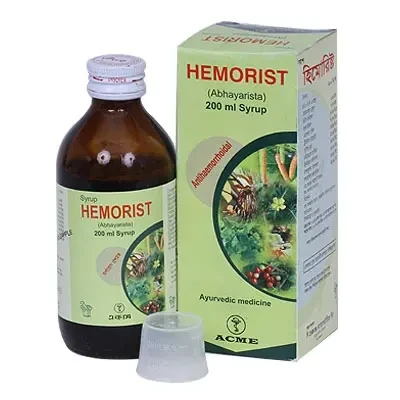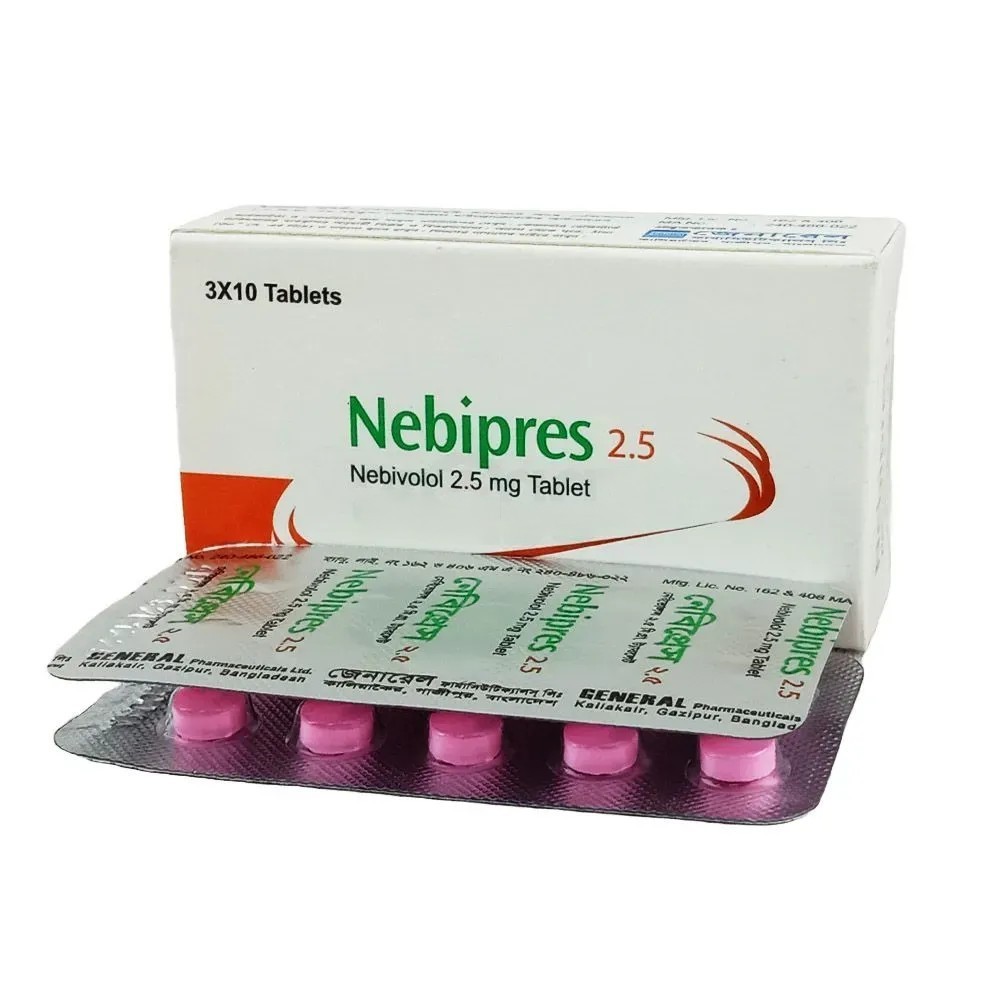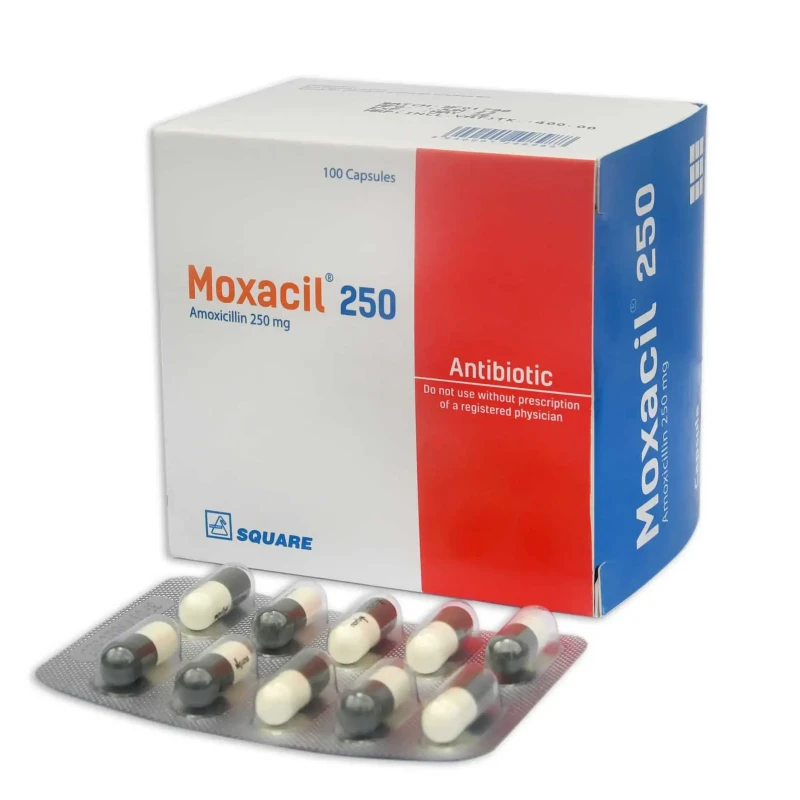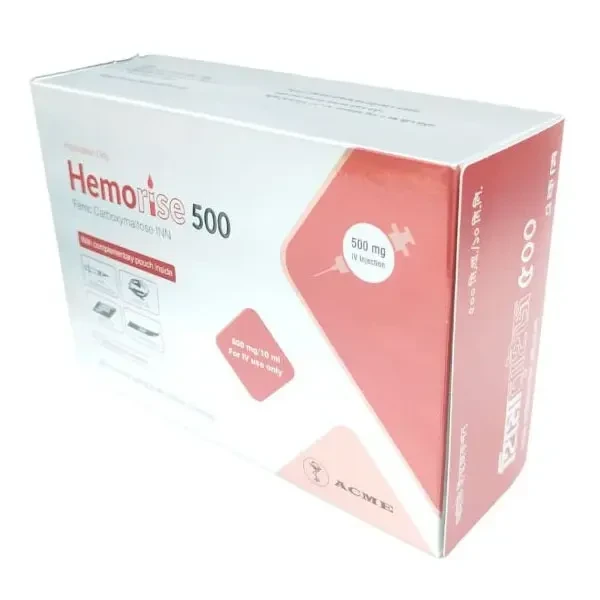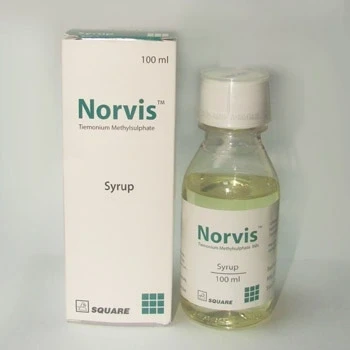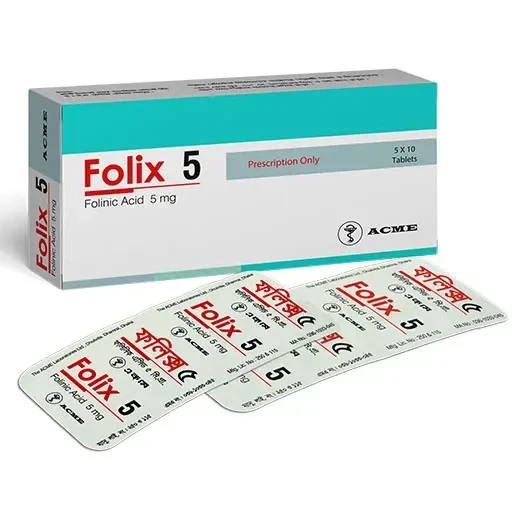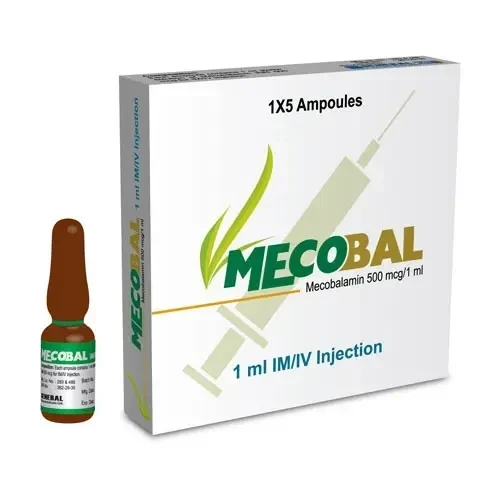

Hexiphen Tablet, Trihexyphenidyl Hydrochloride 5 mg
Inhouse product
-
৳11.40
৳12.00 -
৳42.75
৳45.00 -
৳16.63
৳17.50 -
৳2.14
৳2.25
Reviews & Ratings
Indications
Hexiphen tablet is
indicated as an adjunct in the treatment of all forms of parkinsonism
(postencephalitic, arteriosclerotic, and idiopathic). It is often useful as
adjuvant therapy when treating these forms of Parkinsonism with levodopa.
Additionally, it is indicated for the control of extrapyramidal disorders
caused by central nervous system drugs such as the dibenzoxazepines,
phenothiazines, thioxanthenes, and butyrophenones.
* রেজিস্টার্ড চিকিৎসকের পরামর্শ মোতাবেক ঔষধ সেবন করুন'
Description
Hexiphen exerts a
direct inhibitory effect upon the parasympathetic nervous system. It also has a
relaxing effect on smooth musculature; exerted both directly upon the muscle
tissue itself and indirectly through an inhibitory effect upon the
parasympathetic nervous system.
Pharmacology
Trihexyphenidyl is a
non-selective muscarinic acetylcholine receptor antagonist but binds with
higher affinity to the M1 subtype. In vivo studies have shown that
trihexyphenidyl demonstrates higher affinity for central muscarinic receptors
located in the cerebral cortex and lower affinity for those located
peripherally. Other studies suggest that trihexyphenidyl may modify nicotinic
acetylcholine receptor neurotransmission, leading indirectly to enhanced
dopamine release in the striatum. Although the anticholinergic has proven to be
useful in the treatment of symptoms associated with Parkinson’s disease or
other movement disorders, its mechanism of action has yet to be fully
elucidated.
Dosage &
Administration
Dosage should be
individualized. The initial dose should be low and then increased gradually,
especially in patients over 60 years of age. Whether Trihexyphenidyl may best
be given before or after meals should be determined by the way the patient
reacts. Postencephalitic patients, who are usually more prone to excessive
salivation, may prefer to take it after meals and may, in addition, require
small amounts of atropine which, under such circumstances, is sometimes an
effective adjuvant. If Trihexyphenidyl tends to dry the mouth excessively, it
may be better to take it before meals, unless it causes nausea. If taken after
meals, the thirst sometimes induced can be allayed by mint candies, chewing gum
or water. Abrupt withdrawal of treatment for Parkinsonism may result in acute
exacerbation of Parkinsonism symptoms; therefore, abrupt withdrawal should be
avoided. Abrupt withdrawal of treatment may result in neuroleptic malignant
syndrome (NMS).
Idiopathic
Parkinsonism: As initial therapy
for parkinsonism, 1 mg of Trihexyphenidyl form may be administered the first
day. The dose may then be increased by 2 mg increments at intervals of three to
five days, until a total of 6 to 10 mg is given daily. The total daily dose
will depend upon what is found to be the optimal level. Many patients derive
maximum benefit from this daily total of 6 to 10 mg, but some patients, chiefly
those in the postencephalitic group, may require a total daily dose of 12 to 15
mg.
Drug-Induced
Parkinsonism: The size and
frequency of the Trihexyphenidyl dose needed to control extrapyramidal
reactions to commonly employed tranquilizers, notably the phenothiazines,
thioxanthenes, and butyrophenones, must be determined empirically. The total
daily dosage usually ranges between 5 and 15 mg although, in some cases, these
reactions have been satisfactorily controlled with as little as 1 mg daily. It
may be advisable to commence therapy with a single 1mg dose. If the
extrapyramidal manifestations are not controlled in a few hours, the subsequent
doses may be progressively increased until satisfactory control is achieved.
Satisfactory control may sometimes be more rapidly achieved by temporarily
reducing the dosage of the tranquilizer when instituting Trihexyphenidyl
therapy and then adjusting the dosage of both drugs until the desired ataractic
effect is retained without onset of extrapyramidal reactions. It is sometimes
possible to maintain the patient on a reduced Trihexyphenidyl dosage after the
reactions have remained under control for several days. Instances have been
reported in which these reactions have remained in remission for long periods
after Trihexyphenidyl therapy was discontinued.
Concomitant use with
Levodopa: When Trihexyphenidyl
is used concomitantly with levodopa, the usual dose of each may need to be
reduced. Careful adjustment is necessary, depending on side effects and degree
of symptom control. Trihexyphenidyl dosage of 3 to 6mg daily, in divided doses,
is usually adequate. Concomitant use with other Parasympathetic Inhibitors:
Trihexyphenidyl may be substituted, in whole or in part, for other
parasympathetic inhibitors. The usual technique is partial substitution
initially, with progressive reduction in the other medication as the dose of
Trihexyphenidyl is increased.
The total daily intake of Trihexyphenidyl tablet is tolerated best if divided
into 3 doses and taken at mealtimes. High doses (>10 mg daily) may be
divided into 4 parts, with 3 doses administered at mealtimes and the fourth at
bedtime.
Use in children: Safety and effectiveness in pediatric
patients have not been established.
* রেজিস্টার্ড চিকিৎসকের পরামর্শ মোতাবেক ঔষধ সেবন করুন'
Interaction
Cannabinoids,
barbiturates, opiates, and alcohol may have additive effects with, and thus, an
abuse potential exists. Concurrent use of alcohol or other CNS depressants with
may cause increased sedative effects. Monoamine oxidase inhibitors and
tricyclic antidepressants possessing significant anticholinergic activity may
intensify the anticholinergic effects of antidyskinetic agents because of the
secondary anticholinergic activities of these medications. Prophylactic
administration of anticholinergic agents, such as , as a prevention of
drug-induced parkinsonism during neuroleptic therapy is not recommended. There may
be an increased risk for the development of tardive dyskinesia during
concomitant administration of anticholinergics and neuroleptics. The usual dose
of either or levodopa may need to be reduced during concomitant therapy, since
concomitant administration may increase drug-induced involuntary movements.
Contraindications
Trihexyphenidyl is
contra-indicated in patients with hypersensitivity to Trihexyphenidyl.
Trihexyphenidyl is also contraindicated in patients with narrow angle glaucoma.
Blindness after long-term use due to narrow angle glaucoma has been reported.
Side Effects
Minor side effects,
such as dryness of the mouth, blurred vision, dizziness, mild nausea or
nervousness, will be experienced by 30 to 50 percent of all patients. These
sensations, however, are much less troublesome with Hexiphen than with
belladonna alkaloids and are usually less disturbing than unallenated
parkinsonism. Such reactions tend to become less pronounced, and even to
disappear, as treatment continues. Even before these reactions have remitted
spontaneously, they may often be controlled by careful adjustment of dosage
form, amount of drug, or interval between doses. Isolated instances of
suppurative parotitis secondary to excessive dryness of the mouth, skin rashes,
dilatation of the colon, paralytic ileus, and certain psychiatric
manifestations such as delusions, hallucinations, and paranoia, all of which
may occur with any of the atropine-like drugs, have been reported rarely with
Hexiphen. Potential side effects associated with the use of any atropine-like
drugs, including Hexiphen, include cognitive dysfunctions, including confusion
and memory impairment; constipation, drowsiness, urinary hesitancy or
retention, tachycardia, dilation of the pupil, increased intraocular pressure,
choreiform movements, weakness, vomiting, and headache. Exacerbation of
parkinsonism with abrupt treatment withdrawal has been reported. Neuroleptic
malignant syndrome with abrupt treatment withdrawal has been reported. The
occurrence of angle-closure glaucoma in patients receiving Hexiphen has been
reported (blindness has been reported in some cases). Paradoxical sinus
bradycardia, dry skin, and cycloplegia have been reported. In addition to
adverse events seen in adults, the following adverse events have been reported
in the literature in pediatric patients: hyperkinesia, psychosis,
forgetfulness, weight loss, restlessness, chorea, and sleep alterations.
Pregnancy &
Lactation
There are no
controlled data in animal or human pregnancy. Trihexyphenidyl HCI is only
recommended for use during pregnancy when need has been clearly established and
benefit outweighs risk. It is not known whether this drug is excreted in human
milk. Because many drugs are excreted in human milk, caution should be
exercised when Trihexyphenidyl HCI is administered to a nursing woman. As with
other anticholinergics, Trihexyphenidyl HCI may cause suppression of lactation.
Therefore, Trihexyphenidyl HCI should only be used if the expected benefit to
the mother outweighs the potential risk to the infant.
Precautions &
Warnings
Patients to be treated
with Hexiphen should have a gonioscope evaluation prior to initiation of
therapy and close monitoring of intraocular pressures. The use of
anticholinergic drugs may precipitate angle closure with an increase in
intraocular pressure. If blurring of vision occurs during therapy, the
possibility of narrow angle glaucoma should be considered. Blindness has been
reported due to aggravation of narrow angle glaucoma. Hexiphen should be
administered with caution in hot weather, especially when given concomitantly
with other atropine-like drugs to the chronically ill, alcoholics, those who
have central nervous system disease, or those who do manual labor in a hot
environment. Anhidrosis may occur more readily when some disturbance of
sweating already exists. If there is
evidence of anhidrosis, the possibility of hyperthermia should be considered.
Dosage should be decreased so that the ability to maintain body heat
equilibrium via perspiration is not impaired. Severe anhidrosis and fatal
hyperthermia have occurred with the use of anticholinergics under the
conditions described above. Neuroleptic Malignant Syndrome: A potentially fatal
symptom complex sometimes referred to as Neuroleptic Malignant Syndrome (NMS)
has been reported in association with dose reduction or discontinuation of
Hexiphen. Clinical manifestations of NMS are hyperpyrexia, muscle rigidity,
altered mental status and evidence of autonomic instability (irregular pulse or
blood pressure, tachycardia, diaphoresis and cardiac dysrhythmias).
Overdose Effects
In humans, doses up to
300 mg (5 mg/kg) have been ingested without fatalities or sequelae. However,
rare cases of death associated with Hexiphen over dosages taken in conjunction
with other CNS-depressant agents have been reported or in patients with a
compromised respiratory condition. Hexiphen blood concentrations associated
with the fatalities ranged from 0.03 to 0.80 mg/I.
Signs and Symptoms: Over dosage with Hexiphen produces typical
central symptoms of atropine intoxication (the central anticholinergic
syndrome). Correct diagnosis depends upon recognition of the peripheral signs
of parasympathetic blockade, including dilated and sluggish pupils; warm, dry
skin; facial flushing; decreased secretions of the mouth, pharynx, nose, and
bronchi; foul-smelling breath; elevated temperature; tachycardia, cardiac
arrhythmias; decreased bowel sounds; and urinary retention. Neuropsychiatric
signs such as delirium, disorientation, anxiety, hallucinations, illusions,
confusion, incoherence, agitation, hyperactivity, ataxia, lip smacking and
tasting movements, loss of memory, paranoia, combativeness, and seizures may be
present. The condition can progress to stupor, coma, paralysis, cardiac and respiratory
arrest, and death.
Treatment: Treatment of acute overdose involves
symptomatic and supportive therapy. Gastric lavage or other methods to limit
absorption should be instituted. A small dose of diazepam or a short-acting
barbiturate may be administered if CNS excitation is observed. Phenothiazines
are contra-indicated because the toxicity may be intensified due to their
antimuscarinic action, causing coma. Respiratory support, artificial
respiration or vasopressor agents may be necessary. Hyperpyrexia must be
reversed, fluid volume replaced and acid-balance maintained. Urinary
catheterization may be necessary. It is not known if Hexiphen is dialyzable.
Therapeutic Class
Antiparkinson drugs
Storage Conditions
Store at temperature
not exceeding 30ºC in a dry place. Protect from light.
Frequently Bought Products
Hemorist Syrup 200 ml bottle, Abhayarista
Nebipres Tablet, Nebivolol Hydrochloride 2.5 mg
FoliHair Capsule, Biotin 1000 mcg
Moxacil Capsule, Amoxicillin Trihydrate 250 mg
Norvis Syrup 100ml, Tiemonium Methylsulfate 10 mg/5 ml
Folix Tablet, Folinic Acid 5 mg
Lorno Tablet, Lornoxicam 8 mg
Product Queries (0)
Login Or Registerto submit your questions to seller
Other Questions
No none asked to seller yet
-
৳11.40
৳12.00 -
৳42.75
৳45.00 -
৳16.63
৳17.50 -
৳2.14
৳2.25






